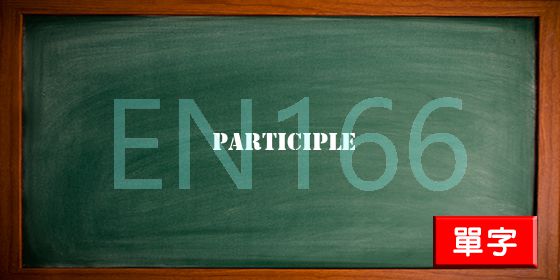participle n.【語法】分詞。 a present [past] p...
n. 【語法】分詞。 a present [past] participle 現在[過去]分詞。 “absolute participle“ 中文翻譯: 獨立分詞“active participle“ 中文翻譯: 主動分詞“dangling participle“ 中文翻譯: 虛懸分詞“fused participle“ 中文翻譯: 溶合分詞“passive participle“ 中文翻譯: 被動分詞“past participle“ 中文翻譯: 過去分詞“perfect participle“ 中文翻譯: 完成式分詞“present participle“ 中文翻譯: 【語法】現在分詞。 “past participle spelling patterns“ 中文翻譯: 過去分詞拼寫形式“present participle construction“ 中文翻譯: 現在分詞結構“usu before a past participle“ 中文翻譯: 通常用于過去分詞之前“participled“ 中文翻譯: adv. 〔俚語〕真,極,怪〔分詞形咒罵語 damned 等的委婉代用語〕。 They are so participled sensitive. 他們真是太敏感了。 “participially“ 中文翻譯: 當作分詞“partick“ 中文翻譯: 帕迪克; 帕提克“participial phrase“ 中文翻譯: 分詞短語“partick mccarthy“ 中文翻譯: 帕特里克麥卡錫“participial noun“ 中文翻譯: 分詞性名詞“partick thistle“ 中文翻譯: 巴特里; 帕爾蒂克“participial adjective“ 中文翻譯: 【語法】分詞形容詞。 “partick wong“ 中文翻譯: 王耀偉“participial“ 中文翻譯: adj. 【語法】分詞(狀)的。 adv. -ly
Third , the participles and strategies to stimulate students “ individuality in chinese teaching , which is the body of this study , related to the three parts : 1 , to be clear about the teaching target 三、在高中語文教學中促進學生的個性發展的原則與策略。這是本文的重點部分,闡述(一)明確高中語文的教學目標、 (二)落實學生的主體地位、 (三)調整教學方式和學習方式三個問題。 |
|
“ very “ is used to modify adjectives and past participles used as adjectives “ very ”用以修飾形容詞和作形容詞用的過去分詞。 |
|
The past participle “ born “ is not used in the passive in this sense 過去分詞“ born ”不用作被動語態。 |
|
“ very “ is used to modify adjectives and past participles used as adjectives “very”用以修飾形容詞和作形容詞用的過去分詞。 |
|
“ strew “ is most commonly used in the past participle form “ strewn “ . “Strew”多見于過去分詞形式“strewn”。 |
|
The past participle “ born “ is not used in the passive in this sense . 過去分詞“born”不用作被動語態。 |
|
Third , the participles and strategies to stimulate students “ individuality in chinese teaching , which is the body of this study , related to the three parts : 1 , to be clear about the teaching target 三、在高中語文教學中促進學生的個性發展的原則與策略。這是本文的重點部分,闡述(一)明確高中語文的教學目標、 (二)落實學生的主體地位、 (三)調整教學方式和學習方式三個問題。 |
|
“ very “ is used to modify adjectives and past participles used as adjectives “ very ”用以修飾形容詞和作形容詞用的過去分詞。 |
|
The past participle “ born “ is not used in the passive in this sense 過去分詞“ born ”不用作被動語態。 |
|
“ very “ is used to modify adjectives and past participles used as adjectives “very”用以修飾形容詞和作形容詞用的過去分詞。 |
|
“ strew “ is most commonly used in the past participle form “ strewn “ . “Strew”多見于過去分詞形式“strewn”。 |
|
The past participle “ born “ is not used in the passive in this sense . 過去分詞“born”不用作被動語態。 |
|
Third , the participles and strategies to stimulate students “ individuality in chinese teaching , which is the body of this study , related to the three parts : 1 , to be clear about the teaching target 三、在高中語文教學中促進學生的個性發展的原則與策略。這是本文的重點部分,闡述(一)明確高中語文的教學目標、 (二)落實學生的主體地位、 (三)調整教學方式和學習方式三個問題。 |
|
“ very “ is used to modify adjectives and past participles used as adjectives “ very ”用以修飾形容詞和作形容詞用的過去分詞。 |
|
The past participle “ born “ is not used in the passive in this sense 過去分詞“ born ”不用作被動語態。 |
|
“ very “ is used to modify adjectives and past participles used as adjectives “very”用以修飾形容詞和作形容詞用的過去分詞。 |
|
“ strew “ is most commonly used in the past participle form “ strewn “ . “Strew”多見于過去分詞形式“strewn”。 |
|
The past participle “ born “ is not used in the passive in this sense . 過去分詞“born”不用作被動語態。 |
|
participled |
|
The thesis mainly studies the assistance model of the structure evolution when the hsla steel is heated , works out the mathematic expression of the grain boundary in the process of interaction between grain boundary and second - phase particle , and develops a new physical model when grain are pinned by the second - phase participle 本文主要研究了碳鋼和微合金鋼在加熱過程中的組織演變規律的部分輔助模型,推導了晶界與二相粒子相互作用過程中變形晶界的數學表達式,建立了新的二相粒子釘扎晶界的物理模型。 |

